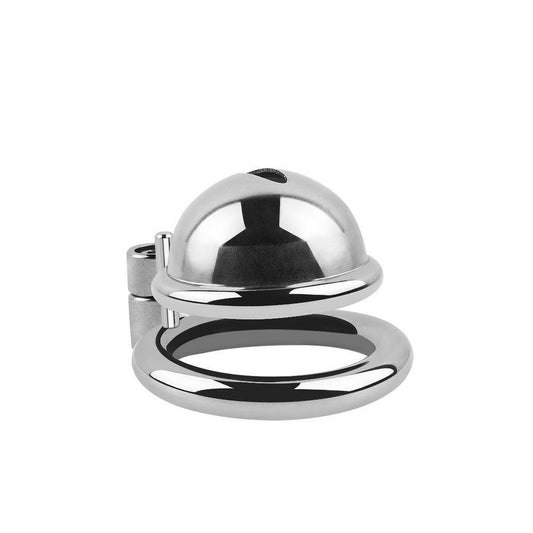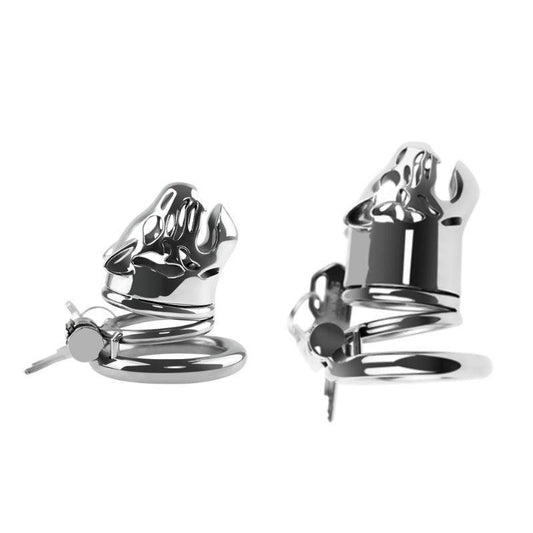Chastity cages are growing in popularity, especially for those exploring power dynamics, self-discipline, or heightened sexual experiences. However, as with any intimate product or practice, safety is a top concern. So, the simple answer to the question "Is using a chastity cage safe?" is yes—as long as it is used properly, fitted appropriately, and maintained with care.
In this post, we will break down the essential safety guidelines for using a chastity cage, including considerations for comfort, hygiene, and general well-being. By following these best practices, you can ensure a safe and enjoyable experience with your chastity device.
1. Proper Fit Is Essential for Safety

The most important factor when it comes to chastity cage safety is ensuring that the device fits properly. An ill-fitting cage can cause discomfort, pain, or even injury over time.
Why Fit Matters:
- Prevention of injury: If the chastity cage is too tight, it can restrict blood flow and cause issues like numbness or, in extreme cases, tissue damage. On the other hand, if it’s too loose, it can cause chafing, rubbing, and potential irritation.
- Comfort for wear: A well-fitted cage ensures that the wearer is comfortable enough to wear the device for extended periods. This is especially important if you plan to wear the device for days or weeks at a time.
What to Look For:
- Measurement: Make sure to measure both the length and girth of your penis to ensure the cage you choose is the right size. Most manufacturers provide sizing charts or offer custom sizing options.
- Adjustability: Some chastity cages have adjustable rings or locks, which can help achieve the perfect fit. Look for a device that offers flexibility and comfort for long-term wear.
- Material choice: Materials like medical-grade silicone, stainless steel, or plastic are typically comfortable, non-irritating, and durable. Choose a material that feels smooth and breathable.
2. Take Regular Breaks to Maintain Circulation

Wearing a chastity cage continuously for long periods can impact circulation, especially if the device is too tight or restrictive. It's important to take regular breaks to ensure the health of your genital area and maintain proper circulation.
Why Breaks Matter:
- Preventing numbness or tingling: Without adequate blood flow, the genitals can become numb or experience tingling sensations, which can be uncomfortable or even harmful if left unchecked.
- Avoiding long-term complications: Wearing a cage for too long without breaks can lead to more serious complications, including the risk of infection or tissue damage. Regular breaks help ensure your genital health and allow your body to rest.
How to Take Breaks:
- Frequency: Depending on how long you plan to wear the chastity cage, it’s generally recommended to take breaks every few hours or at least once a day. If you're wearing the cage for extended periods (such as days or weeks), consider removing it for short intervals to let your body recover.
- Alternating periods: If you're practicing extended chastity, you can also alternate between periods of wearing the cage and being uncaged. For example, wearing it for a few days followed by a day or two of freedom is a common practice.
3. Hygiene and Cleaning for Safety

Good hygiene is crucial when wearing a chastity cage. Keeping the device clean helps prevent infection and irritation, ensuring that your experience is safe and comfortable.
Why Hygiene Is Crucial:
- Preventing infections: A dirty cage can harbor bacteria, especially in sensitive areas such as the penis and scrotum. This can lead to infections or rashes if not properly cleaned.
- Avoiding irritation: Sweat and moisture can build up inside the cage, leading to skin irritation or chafing if not cleaned regularly.
Best Hygiene Practices:
- Daily cleaning: Remove the chastity cage daily to clean both the device and the genital area. Use mild soap and warm water to clean the cage, and avoid harsh chemicals that could irritate the skin. Be sure to rinse thoroughly.
- Dry thoroughly: After cleaning, dry the device and genital area completely before locking the cage back on. Dampness can contribute to bacterial growth and skin irritation.
- Monitor skin health: Keep an eye out for signs of redness, irritation, or chafing. If you notice any issues, consider taking a break from the device until the area heals.
4. Consider the Duration of Wear

While it can be tempting to wear a chastity cage for long periods, it’s important to recognize that extended wear requires careful attention to both the device and your body. Generally, short to moderate periods of wear (a few hours to a few days) are considered safe for most people. However, if you are planning to wear a chastity cage for extended periods (weeks or months), there are extra precautions to keep in mind.
Safety Considerations for Extended Wear:
- Regular check-ins: If you plan to wear the cage for extended periods, it's essential to check in with your body regularly. Look for signs of discomfort, swelling, or restricted blood flow, and adjust the fit or take breaks as necessary.
- Emergency removal: Always have a plan for quick and easy removal in case of an emergency. Keep the key or combination in an accessible location so that you can remove the cage if needed.
- Periodic rest: For longer wear (beyond a few days), ensure you take regular breaks from the cage. Extended periods of time in the device can cause psychological and physical discomfort, so balancing chastity with freedom is crucial.
5. Communication with Your Partner

If you are using a chastity cage as part of a BDSM or D/s (dominance and submission) dynamic, communication with your partner is key to ensuring safety and comfort.
Why Communication Matters:
- Consent and boundaries: Clear communication helps ensure that both parties are on the same page regarding limits, safety, and comfort. Discuss any discomfort or concerns openly with your partner.
- Safe words and signals: Establish safe words or signals to communicate during play. If the wearer experiences pain, discomfort, or needs a break, it’s important that they can express this without hesitation.
6. Choosing a Quality Device

The safety of wearing a chastity cage is closely linked to the quality of the device. Not all chastity cages are created equal, so choosing a high-quality product is essential to your safety.
What to Look For:
- Durability: A well-made chastity cage should be durable and resistant to wear and tear. Look for products made from high-quality materials such as medical-grade stainless steel, silicone, or plastic.
- Comfortable design: A well-designed cage should minimize discomfort, with smooth edges, a breathable structure, and a lightweight feel.
- Reputable brands: Choose brands with good customer reviews and a reputation for safety and quality. Look for detailed sizing information and clear product descriptions to ensure the cage meets your needs.

Conclusion: Is Using a Chastity Cage Safe?
Using a chastity cage can be a safe and enjoyable experience as long as the device is used properly, fitted correctly, and maintained with care. Prioritizing comfort, hygiene, and regular breaks is key to avoiding physical discomfort or injury. By being mindful of the safety practices outlined above, you can enjoy the benefits of chastity play while minimizing any risks to your health and well-being.
Remember, the ultimate goal is to create a safe and consensual environment for exploration and enjoyment, so always listen to your body, communicate openly with your partner, and ensure that the chastity device you choose fits properly and is maintained in good condition.
Looking for the right chastity cage for your needs? Visit lockedmenclub.com today to explore our wide selection of high-quality, comfortable, and durable chastity cages. Shop now for your perfect fit and enjoy a safe and fulfilling experience.








